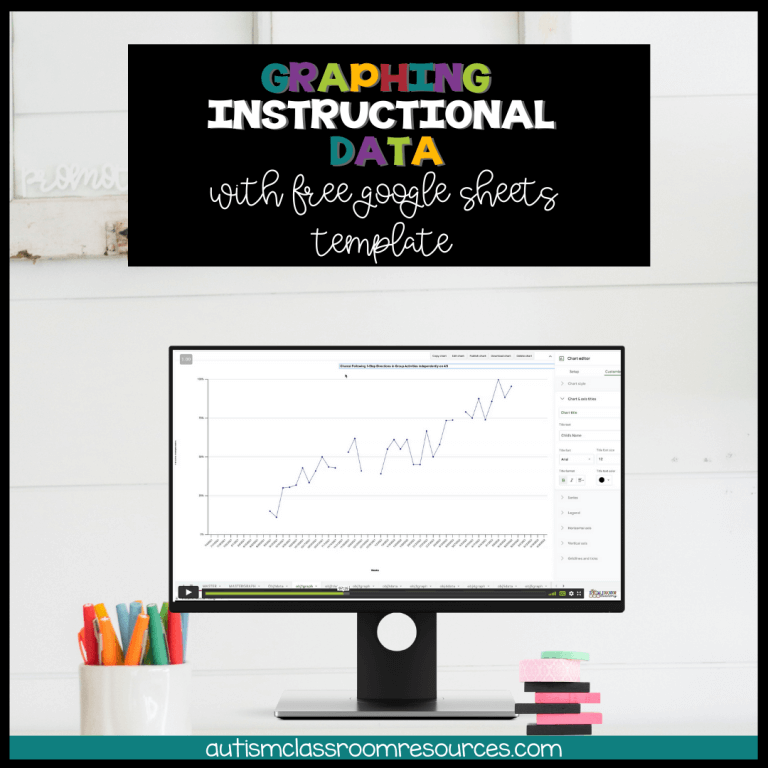In the past few posts I have been talking about data collection and offered some strategies that I hope would be helpful. Today I thought I would attempt to pull all those together to show you the system I use in planning data collection. I plan data collection across a classroom by using the students Comprehensive Autism Planning System – Teaching Plan (CAPS) that I have talked about in previous posts. If you go back and look at some of the examples, you can see where I have indicated the data collection strategy for the skill. That strategy is chosen based on the skill itself and how it would best be measured and the environment in which the teaching is taking place.
Different skills and teaching environments require different data collection procedures. You have to find a data collection system that doesn’t interfere with engaging with the students. With that said, you also have to use a data system long enough for it to become a habit-at least 2 to 3 weeks–before you say it won’t work. Here are some forms that data can take.
1. Work Product.
This is one of the easiest of them all but it’s important to remember to record information that allows you to interpret the results. So make sure it has the date and any assistance that was given to the student to complete it. If it’s a writing assignment and had a writing prompt or a question, make sure that is included as well.
2. Tests
If you can give a periodic test, like a spelling test, and assess the skill accurately, give a test. Again, this is a quick probe / sample and just make sure you have the same information you would include on a work product.
3. Event-by-Event Data or Trial-by-Trial Data
This is when you take data on every instance of the behavior, like when you take trial data on every trial in discrete trials.
4. Sample Data
This is when you are taking data on one specific day or during one particular activity on a regular basis. I talked about this in the last few posts and the importance of making sure that you take it consistently and only in the sample period. The naturalistic data sheet I shared in the last post takes a sample of the skills during different activities.
So, how do you pull it all together?
First, I would complete the CAPS and determine the best data collection systems for each skill I am trying to track for each student in the class. This also assures that every skill from the IEP is tracked in some method of data collection. In making these decisions these are my guidelines for instructional data. I will talk about data for challenging behavior in a future post.
- For anything using discrete trials or any skills that the data indicates the student is struggling with, I take event-by-event data on a discrete trial data sheet. Unfortunately I can’t share those sheets at this point as they are being prepared for the data book Dr. Kabot and I are writing. However, if you do a search there are several and most folks trained in discrete trials have their own that they use. I also use event-by-event or trial-by-trial data for many task analyses jobs that are done one time a day like laundry, cleaning, and dressing. Since this is something that only happens once a day or in some cases with community-based instruction one time a week, I need to capture enough data points to make decisions. To do that I need to take the data whenever the skill is performed.
- For any skill that produces a permanent product or can be tested, I would record prompting, date, and other pertinent information on the product or the test and keep a copy (or a picture from my phone if I need to send it home).
- For any skill that is being taught in the natural environment and there are multiple opportunities to practice the skill, I would take a weekly sample, usually in 2 activities across the week. I would use the naturalistic data sheet I talked about in the last post to do this, whether as an individual or for a whole group. This data would then need to be summarized in a graph and analyzed, and that is where the next post will pick up with a freebie system for graphing in Excel and hopefully a screencast of how to use it.
- For independent work, I typically use the task analysis data sheet that is part of our Building Independence: How to Create and Use Structured Work Systems book once a week to track the skills of the system that the student is able to complete independently. (This is an affiliate link that yields me a small commission but the cost is the same to you. See more in my disclosure statement.)
So, how do you take data in your classroom? Sound off in the comments!
Until next time,








